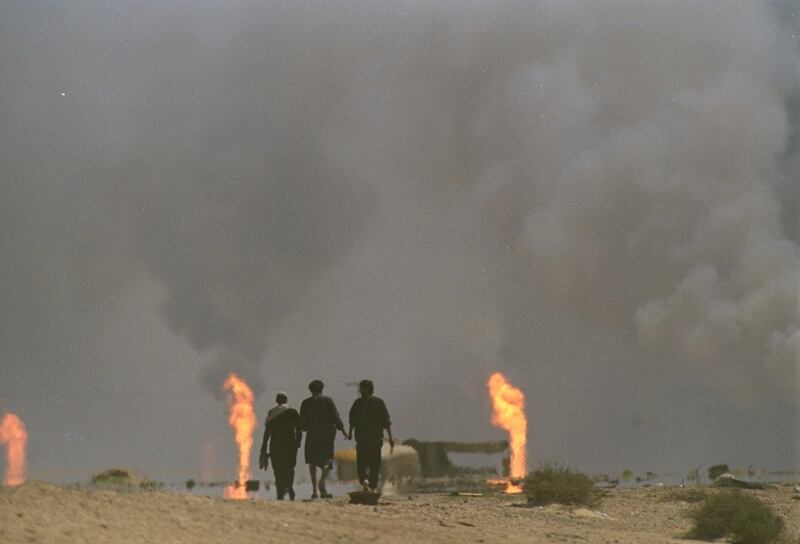Four days before US troops invaded Iraq for the first time, on January 13, 1991, Saddam Hussein issued a small but vital law.
It concerned the flag of Iraq, a red, white and black tricolour with three green stars. The new law changed the flag, adding the Arabic words "God is great" between the stars.
A small law issued in the midst of a gathering storm. But 25 years on from the Iraqi invasion of Kuwait that triggered the first Gulf War, it is apparent that this law, and particularly the political philosophy behind it, began a process that created the conditions for ISIL's success.
The road map that leads from the centralised Iraqi state of the 1990s to the disintegrating Iraq of today, starts in the 1980s, when Saddam Hussein's regime began to stutter.
The astonishing development of the 1970s began to slow under pressure from Saddam's ill-conceived war against Iran.
Saddam was particularly concerned about religious challenges to his rule during this period. Aside from the war against Iran, launched at least in part because of the fear of a new revolutionary Iran, the Muslim Brotherhood was also gaining support in Iraq, as it was in other Arab countries.
Saddam's response was to seek to co-opt religion for his own political purposes. By engaging with Salafism, a more austere version of Islam, Saddam believed he could find a way to control a revivalist Islam and exploit it for his own aims.
______________________________________________________________
Read more about the aftermath of the 2003 invasion:
■ Why Iraqi sectarianism is a persistent lie
■ America already tried imperialism in the Middle East – and it failed
______________________________________________________________
By the time of the first Gulf War, this idea rapidly became a means of survival for the regime. Having invaded Kuwait and finding himself opposed by most Arab countries, Saddam lost his (self-declared) role as a defender of the Arabs and heir to the mantle of Arab nationalism. He turned, instead, to religion as a justification for his rule.
In the aftermath of the 1991 war, Saddam launched his hamla imaniyya, a faith campaign that sought to entrench Islam across the Baath party and Iraqi society. Religious instruction became mandatory, and the ostensibly secular society he took over in 1979 morphed into a society with religion – or at least the outward signs of devotion – at the heart of it.
What does all of this have to do with ISIL?
To understand that, we have to look at a former Iraqi intelligence officer called Samir Al Khlifawi.
In documents uncovered in Aleppo by the German magazine Der Spiegel, it became clear that Al Khlifawi, going by the pseudonym Haji Bakr, had set up a meticulous plan for ISIL's growth and success, based in significant part on his experience as part of the Iraqi regime.
Perhaps the most telling part of the plans as outlined in the documents was a re-run of Saddam's exploitation of religion.
Al Khlifawi, Der Spiegel claimed, wanted to put a religious face on the militant group, and used Abu Bakr Al Baghdadi. Whether or not that specific element of the story is true, the composition of the ranks of ISIL undoubtedly follows the Khlifawi playbook.
By recruiting under the banner of religion, ISIL has swelled its numbers with foreigners – Tunisians, Britons, Uzbeks and other Asians. The group may be led and directed by Iraqis, but very few of the recruits are from either Syria or Iraq.
This solves one of the most critical issues that Saddam faced in his attempt to "Islamise" his regime: the possibility that his followers might recognise a difference between religious rhetoric and his actions.
Any attempt to justify political action with religious teachings faces a barrier: what to do about those actions you wish to carry out but are expressly forbidden by the religion?
Saddam faced this problem early. During the 1991 war, Saddam sought to attack Saudi Arabia as a way of drawing the war more widely and getting the US to stretch their forces.
But the immediate justification for attacking Saudi Arabia was problematic: not only was Saudi an Arab country, it was also the seat of the two holiest places in Islam.
Seeking a justification, Saddam argued that, by relying on US troops to defend Mecca and Medina, Saudi Arabia's rulers had violated their role as leaders of the Muslim world. (Some might recognise this argument: Osama bin Laden made it in his first "declaration of war" 15 years later.)
In essence, Saddam sought to do to an entire country what ISIL would later do to entire communities: excommunicate them from Islam and therefore make them "legitimate" targets, a practice known as takfirism.
ISIL has adopted this practice enthusiastically, excommunicating entire sects (such as Shia Muslims). But by drawing their recruits mainly from non-Arabs, they sidestep the possibility that some of those recruits might point to the Quran and ask where, precisely, such death and destruction is sanctioned.
The 25 years since the invasion of Kuwait have seen numerous changes, in Iraq and across the Middle East. ISIL was not created in a day, but from the ashes of specific political decisions – decisions taken at the beginning of the 2003 invasion and over many years since.
But the co-option of religion for political purposes remains at the heart of their system of control, and it grew out of a peculiarly Iraqi soil, out of a specific political context that existed in Iraq.
When Saddam Hussein was hanged, ISIL did not exist. But Saddam had already sown the seeds that, in the right conditions, could flourish into the militant monster of today.
falyafai@thenational.ae
On Twitter: @FaisalAlYafai





